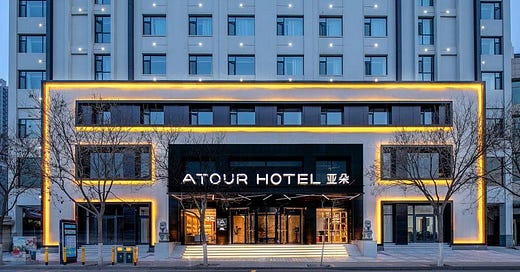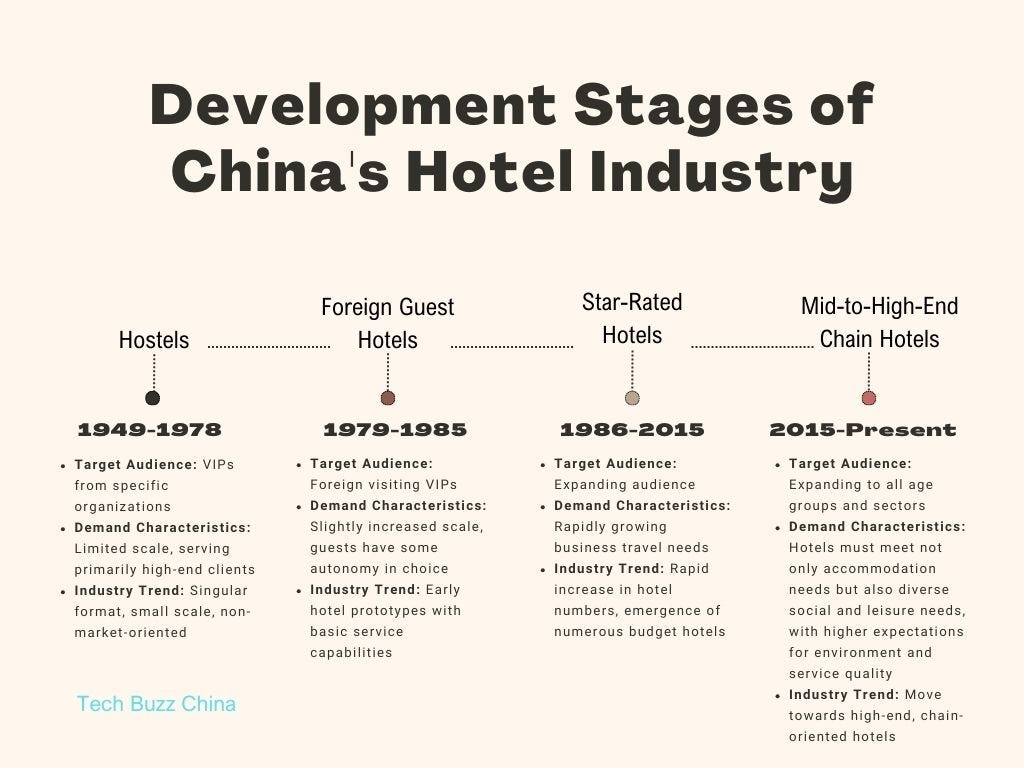How Much Longer Can Atour's Meteoric Rise Last?
From hotel to retail: when pillows outshine the hotels they belong to
Table of Contents
Things that Caught Our Attention
Rapid Growth of Mid-to-High-End Hotels
Are you an investor ready to dive deep into China's thriving electric vehicle ecosystem? Seize this unique opportunity to immerse yourself in the heart of innovation with Tech Buzz China’s Exclusive Electric Vehicle Trip!
Over the course of an exhilarating week, you'll explore two to five vibrant cities and get exclusive access to eight to ten top EV manufacturers, cutting-edge battery producers, and trailblazing LIDAR technology innovators. This isn’t just a tour—it’s a deep dive into one of the world’s most dynamic EV markets.
Spaces are extremely limited, secure your spot now and drive your knowledge to the next level!
Sign up by July 31, 2024, to get a 5% early bird discount.
Click here to read feedback from investors about our last EV trip.
Things that Caught Our Attention
After a nine-month investigation, the European Commission will impose temporary anti-subsidy taxes on Chinese battery electric vehicles. The taxes, effective July 5, 2024, will be 17.4% for BYD, 19.9% for Geely, and 37.6% for SAIC. Other cooperating manufacturers will face a 20.8% tax, while non-cooperating companies will be taxed at 37.6%. These measures can last up to four months, during which EU member states will vote on extending them to five years. (Source: Sohu)
According to a report on July 4, Xiaohongshu has started a new round of layoffs. An employee mentioned that no official announcement has been made yet. Another source said the new management is unhappy with Xiaohongshu's current efficiency, believing it is only half as efficient as Pinduoduo. (Source: 凤凰网科技)
On the evening of July 2, Seres announced that its subsidiary, Seres Auto, will use 2.5 billion RMB of its own funds to buy 919 trademarks and 44 design patents from Huawei Technologies and its affiliates. These include trademarks from the AITO, AIITO, AITOAUTO, and AITO SELECT series. Seres stated that the price was mutually agreed upon, using the asset valuation as a reference. This acquisition will not affect their cooperation but will strengthen their relationship, a point emphasized in the agreement and announcement. (Source: OFweek)
Introduction
A few years ago, a friend in Shenzhen first introduced me to Atour, a hotel with a so-called "internet-driven approach". You've probably guessed that the quotes imply skepticism. I often find in China, businesses use "internet" as a buzzword just to emphasize better service or user experience compared to their competitors. Since then, it has frequently appeared in my WeChat subscription articles on tech and retailing.
Fast forward to the Spring 2024 Tech Buzz China EV Trip, where the buzz among investors turned our conversations towards Atour Hotel once again. Intrigued by their interest, I decided to extend my stay at Atour after the trip, blending curiosity with professional insight. This experience gave me the perfect opportunity to explore Atour Hotel’s operations up close, and this issue is the result of my findings.
Founded in 2013, Atour (亚朵), a unique player in the Chinese hotel industry, has experienced a decade of golden growth. The name "Atour" originates from a small village on the China-Myanmar border in Yunnan's Nujiang region. It represents nature, tranquility, warmth, and simplicity. While the village may lack material wealth, it thrives on spiritual happiness and harmony.
Inspired by this brand story, Atour aims to offer consumers a philosophy of warmth, culture, and fun, advocating for genuine connections between people. This resonates with the modern Chinese urban youth's desire to escape the hustle and bustle and find leisure during their travels. In 2021, the "Atour Index" joined Hema and Starbucks as one of the key measures of urban fashion trends in China.
Atour boasts six accommodation brands: A.T.HOUSE, Atour S Hotel, ZHOTEL, Atour Hotel, Atour X Hotel, and Atour LIGHT, covering mid-range, mid-to-high-end, high-end, and luxury segments. Starting from hospitality, the company has since expanded into scenario-based lifestyle retail. It developed three major brands, "ATOUR PLANET," "SAVHE," and "Z2GO&CO.," which span the fields of sleep, fragrance & personal care, and travel.
In November 2022, Atour Group (NASDAQ: ATAT, market cap 2.45 billion USD) was listed on NASDAQ at $11 per share, opening at $15.50, a 40.9% increase. The company initially aimed to list on the A-shares in 2017, but after two failed attempts, it shifted focus to the US market. In June 2021, it filed for a NASDAQ IPO but withdrew just before listing. After three failed attempts, Atour made it on its fourth try.
According to its financial report, Atour's retail business revenue grew to 972 million RMB in 2023, accounting for 20.81% of its total revenue, surpassing the income from its self-operated hotels. The memory pillow, "Deep Sleep Pillow Pro," has become a bestseller in Atour's retail lineup. Atour's pillows dominate the Tmall bestseller list, with three out of the top five spots. In its 2023 financial report, Atour highlighted its "Double 11" performance: the GMV of its pillow brand on third-party e-commerce platforms exceeded 250 million RMB, a sixfold increase compared to the 2022 "Double 11" sales.
Beyond its main hotel business, Atour's retail business seems gradually emerging as a second growth curve. Atour describes its retail business as "scenario retail." Its hotels and rooms serve different purposes. What are these purposes?
In today's issue, we dive into the fascinating journey of Atour's rise to becoming a premier mid-high-end hotel chain. Discover the strategic moves and key decisions that propelled them to success. We'll also take an in-depth look at how Atour's operational efficiency compares with one of its major competitors, Huazhu Hotels Group. Additionally, we’ll explore investor perspectives on Atour's business performance and potential. Join us for an in-depth exploration of Atour's business landscape.
Freya Zhang, Research Editor
Why a Mid-High-End Brand?
Before Atour was established, the local hotel industry in China was experiencing rapid diversification. Chinese hotels are categorized into five types based on quality and price: budget, mid-range, mid-to-high-end, high-end, and luxury. Budget hotels provide basic accommodation with minimal additional services, while mid-range hotels are typically three-star establishments according to the China National Star-Rating System (CNSRS). Mid-to-high-end hotels correspond to four-star ratings, high-end hotels are five-star, and luxury hotels are premium five-star establishments.
Prior to Atour's establishment, international brands like Marriott and Hilton dominated the luxury and high-end hotel market with their five-star reputations. Meanwhile, local hotel brands such as BTG Homeinns (SHA: 600258, market cap 15.7 billion yuan), Jin Jiang (SHA: 600754, market cap 26.31 billion yuan), and Huazhu (NASDAQ: HTHT, market cap 2.45 billion dollars) expanded rapidly from either the low-end or mid-range segments, achieving significant scale with thousands of hotels. By the time Atour was founded in 2013, both the mid-to-low-end and high-end markets were highly competitive in China.
Rapid Growth of Mid-to-High-End Hotels
The Chinese hotel industry has undergone four distinct development stages. In the early days, hotels mainly served high-end clients with limited market-oriented structures and inadequate service capabilities. Following the economic boom sparked by the reform and opening-up policies, the demand for hotels surged as inter-regional and business travel became more frequent, and leisure travel grew. This period saw the emergence of numerous budget hotels.
Since 2015, the hotel industry has reached a new turning point. With increased consumer spending power, hotel customers began demanding better environments and services. Mid-to-high-end hotels, offering strong service capabilities, clean and comfortable environments, and diverse social functions, became increasingly popular.
Several factors contributed to this shift. Between 2013 and 2021, the average disposable income of Chinese residents grew at a compound annual growth rate (CAGR) of 8.5%, reaching 35,000 RMB. During the same period, the urbanization rate (the proportion of urban population) rose from 54.5% to 64.7%. Enhanced purchasing power and ongoing consumption upgrades expanded the demand for mid-to-high-end hotels.
Business travelers, in particular, began seeking higher quality accommodations, leading to a rise in bookings for mid-to-high-end hotels. In 2020, 82% of business travelers in China chose to stay in high-end and mid-range hotels during business trips. The proportion of business hotels with an average price above 500 RMB increased from 14.3% in 2019 to 29.7% in 2021, reflecting the growing demand amid economic prosperity and frequent business travel. Between 2016 and 2021, the number of mid-range and mid-to-high-end hotels grew at CAGRs of 26.6% and 28.5%, respectively, marking the fastest growth among all categories.






